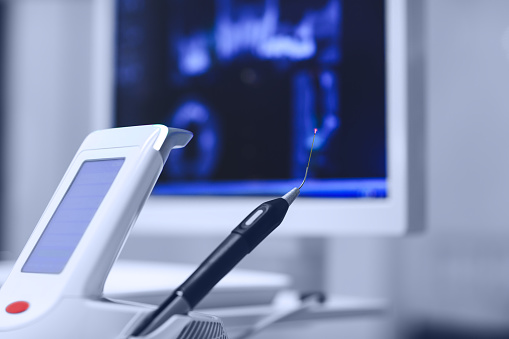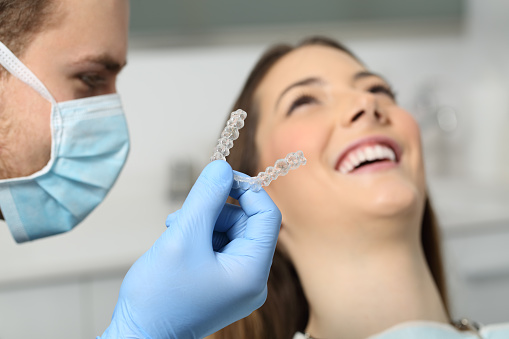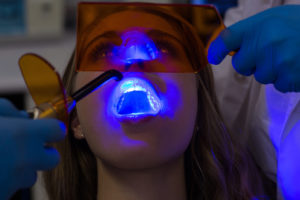-
Is Laser Dentistry the Answer for Your Dental Phobia?
If going to the dentist makes you anxious, you are not alone. Fortunately, your dentist has a strategy that can help you approach dental care with more confidence: laser dentistry. Laser dentistry has dramatically changed the way that dentists perform a wide range of treatments, and as a result, more and more people who suffer from dental phobias are finding their ways back to the chair for treatment. Could laser dentistry be the solution for your anxiety about seeing the dentist? Here are some of the advantages of laser dentistry that make getting care easier than ever.

Treatments Without the Drill
Laser dentistry makes it possible for you to get treatments, such as fillings, without the use of a drill. Many people who are anxious about dental care dread the sound, vibration, and smell of the dental drill, but with the help of lasers, it can be replaced completely. In some cases, laser dentistry treatments can be performed without any anesthesia at all, which means patients also avoid the injection of local anesthesia that many dislike. Even when anesthesia is necessary, it is usually possible to use much less during laser treatments, which means fewer shots and a faster recovery.
Faster Treatment Times
Laser dentistry allows for more precise treatments, which means procedures can be completed much faster. Treatment times are also reduced because little to no anesthesia is required. Patients who experience dental phobia usually appreciate the ability to have shorter appointments with faster treatment times.
Easer Post-Treatment Recovery
Because the dental laser reduces the need for drilling, there is far less bleeding and swelling during and after treatment. For most people, this means that there is much less tenderness and bleeding after treatment, allowing you to return to your usual activities faster.
Do you have questions about laser dentistry in Hazlet? Call Glenwood Premier Dental to learn more about our laser treatments and to make an appointment for dental care. Dial (732) 264-4477 to talk to a team member today.
Implant Dentistry: What You Need to Know About Restoring Your Smile
If you have missing teeth, it’s natural to feel a little self-conscious about your smile. Fortunately, your dentist can help you regain your confidence in flashing your grin with natural-looking, comfortable dental implants. Could you be a candidate for dental implants? The best way to find out about restorative care, including dental implants, is to schedule an appointment with your dentist for a consultation. The answers to these common patient questions about dental implants will also help you understand your options for restoring your smile.

What are dental implants?
Dental implants consist of a metal post that is implanted into your gum tissue to act as an artificial tooth root. A dental crown, designed to match your natural teeth, it attached to the post via an abutment. Once in place, dental implants look and feel like natural teeth. You can eat and speak as normal and brush and floss them just like your teeth. Many people who are missing teeth find that dental implants are more comfortable and require less maintenance than dentures.
Who can benefit from dental implants?
Dental implants can work for people are missing one tooth as well as people who are missing all of their teeth—and everything in between. Dental implants are safe and effective for most people, but you must have enough bone in your jaw to adequately support the implants. If your dentist thinks that you not have enough bone, he or she may recommend bone grafting before you get dental implants.
How long do dental implants last?
With proper care, dental implants can last indefinitely. Brush and floss them as you would your normal teeth, and continue to have regular teeth cleanings with your dentist. You can’t get a cavity in a dental implant, but gum disease can occur around an implant, so maintaining a good hygiene routine is critical.
Find out how dental implants can change your smile by making an appointment at Glenwood Premier Dental for a consultation. Schedule a visit to discuss dental implant in Hazlet by calling (732) 264-4477.
How Laser Dentistry Makes It Possible to Ditch the Drill
If the idea of going to the dentist makes you anxious, you may be happy to know that reaching for the drill no longer has to be part of your care. Laser dentistry lets your dentist perform a number of different treatments that used to involve the dreaded drill with much less discomfort and greater precision than ever before.

Laser dentistry replaces drilling with laser energy. Using the laser, your dentist can do fillings, treat gum tissue, remove oral growth, and etch tooth surfaces without cutting or drilling. As a result, treatments are faster, more comfortable, and cause less bleeding. Many laser dentistry procedures can be done without anesthesia, and those that require anesthesia need much less than they would with other treatment methods.
Don’t let fear of the dentist keep you from getting the care you need. At Glenwood Premier Dental, we offer judgment-free dental care designed with your comfort in mind and use the latest technology to make seeing the dentist easy and stress-free. To learn more about laser dentistry in Hazlet, call (732) 264-4477.
How Oral Health Affects Your Heart Health
When you visit your dentist for an exam and teeth cleaning, you aren’t just taking care of your oral health. The health of your mouth has implications for your systemic health as well, especially the health of your heart.
Watch this video to learn about the impact of oral health on your heart health. Bacteria in gum tissue can cause inflammation in your blood vessels that is dangerous for your heart. Regular teeth cleanings are likely to be part of your care plan if you have heart disease, and they are an important part of preventing heart disease if your heart is currently healthy.
At Glenwood Premier Dental, we provide comprehensive dental care for everything from gum disease to oral cancer. Make an appointment with our dentist in Hazlet by calling (732) 264-4477.
Examining Different Types of Tooth Pain
If you’re experiencing tooth pain, it’s always a good idea to call your dentist as soon as possible to determine the cause and get the treatment you need. Not all tooth pain is created equal, and the different symptoms you are having will help your dentist decide what kinds of treatments will be most effective in bringing your relief. Here is a look at some different types of tooth pain and what they may mean.

Sharp Pain While Biting
If you experience a sudden and sharp pain when you bite into food, there is a chance that you have decay in one of your teeth. A loose filling or a crack in your tooth can also cause these symptoms. If you have decay, you may need a filling or a root canal. If you have a loose filling, it will need to be replaced. There are several treatments your dentist may consider if you have a crack in your tooth, including bonding treatments and veneers.
Sensitivity After Hot or Cold Foods
Tooth sensitivity can cause a shock of pain when hot or cold foods come into contact with your teeth. If the discomfort only lasts for a second or two, then you may be in the early stages of gum disease or have minor tooth decay. Often, switching to a soft-bristled toothbrush and being vigilant about brushing or flossing will reverse this issue. For sensitivity that is more persistent, your dentist will determine if you have a physical trauma to your teeth that is causing the pain or if you have deep decay. If decay is the issue, you may need a root canal.
Constant Throbbing Pain
If you have constant, severe throbbing pain, then you could have a tooth abscess. Tooth abscesses are painful and can be extremely dangerous if they rupture. If this happens to you, you may need emergency dental care.
At Glenwood Premier Dental, we can help you with all types of tooth pain, whether you need a root canal or emergency dentist treatment. To schedule an appointment with a dentist in Hazlet, call (732) 264-4477.
Reasons to Consider Invisalign for Teeth Straightening
If your teeth aren’t as straight or evenly spaced as you would like, braces aren’t your only option. Invisalign will give you the same results as braces without the need for brackets and wires. If your dentist has told you that you’re a good candidate for Invisalign and you’re trying to decide if you want to go forward with treatment, here are some of the reasons you may want to pick this unobtrusive solution for orthodontic issues.

Invisalign aligners are virtually invisible.
For some people, the idea of wearing metal brackets and wires keeps them from getting the orthodontic care that they need. With Invisalign, you don’t have to wear braces to get straighter teeth and to feel better about your smile. Invisalign coaxes your teeth into more desirable positions using clear aligners that snap over your teeth. They are virtually invisible, so no one has to know that you are getting orthodontic care but you. These aesthetic advantages are especially important to adults who are concerned about the impact that braces could have on their careers.
With Invisalign, you don’t need a special diet or oral care routine.
Invisalign aligners snap in and out of your mouth with ease. Whenever you eat or brush your teeth, simply remove the aligners and proceed as normal. This advantage is significant when compared to braces, which require you to avoid hard and chewy foods and that force you to adopt a new way of brushing and flossing. The ability to take your aligners out is also helpful if you play sports or a musical instrument.
Invisalign delivers faster results than braces.
Although every treatment plan is different, Invisalign usually provides results faster than braces. In many cases, choosing Invisalign can significantly reduce treatment times. Your dentist can help you understand what your treatment plan will be and how long you will need to wear your aligners to get the results you want.
Find out if you are a good candidate for Invisalign by making an appointment at Glenwood Premier Dental. Our dentist in Hazlet can help you decide on the right combination of cosmetic dentistry treatments to help you feel confident in your smile. Make an appointment today by calling (732) 264-4477.
Removing Oral Growths with Laser Dentistry
Since unusual growths and lesions can sometimes indicate oral cancer, it’s important to see your dentist right away if you notice these abnormalities. Fortunately, not every oral growth is caused by cancer, although even benign growths can be problematic for patients. When benign oral growths are causing discomfort or other symptoms, a dentist can use sophisticated laser dentistry to remove them.

Laser dentistry can safely and effectively remove growths like benign fibromas and enlarged papillae. This dental technology was developed specifically to enhance patient comfort by using gentle lasers and a spray of water to replace more invasive oral surgery tools. This makes it a great choice for patients who are nervous about having oral treatments performed. Thanks to the gentleness of the technology, there is very little bleeding involved, even when removing tissue growths. Plus, the healing process is more comfortable.
Glenwood Premier Dental is pleased to provide the latest in dental technology, including state-of-the-art laser dentistry. Call (732) 264-4477 to request an appointment for laser dentistry services in Hazlet.
What Exactly Is Plaque?
Plaque is a sticky biofilm that adheres to teeth. It’s primarily made up of bacteria. If plaque is allowed to stay on your teeth, it will harden into tartar and begin to eat away at the enamel, causing dental caries or cavities. You can remove plaque with a toothbrush and floss, but you’ll need to see your dentist to get rid of tartar, as this substance is much harder.
You can learn more about plaque when you watch this video clip. It explains that various bacteria specialize in different functions. Some bacteria are exceptionally good at sticking to the teeth, while other types specialize in dissolving the tooth enamel. You’ll also learn why dentists fill in more cavities on the back teeth compared to the front, and how poor dental care can lead to loose teeth and tooth loss.
Residents near Hazlet can get a professional teeth cleaning at Glenwood Premier Dental. Call (732) 264-4477 today to schedule an appointment.
FAQs about Your Tooth Restoration Options
Restorative dentistry refers to any approach a dentist uses to replace a missing tooth or restore a natural tooth that is missing part of its structure. As you might imagine, restorative care is a broad category of dentistry that encompasses numerous types of treatment. Your dentist will help you choose the most appropriate restorative option for you, based on your specific oral health needs.

What are direct and indirect dental restorations?
A direct dental restoration is any procedure done to restore the tooth that can be completed in just one office visit. As an example, you can have a dental cavity treated and filled in just one office visit. The filling is a restoration, since it replaces the missing part of the enamel. Indirect dental restorations are more complex, and typically require multiple office visits. Some examples of indirect dental restorations are:
- Inlays and onlays
- Crowns
- Bridges
- Dentures
What’s the difference between inlays and onlays?
Inlays and onlays are both types of restorations that are suitable for treating tooth decay. They can also be used to treat minor cracking or fracturing as an alternative to crowns. An inlay fits within the tooth’s biting surface. An onlay covers part or all of the chewing surface. Both of them can be made of porcelain, composite resin, or gold.
Are there different types of crowns?
All crowns are made to fit permanently over a damaged natural tooth. The crown itself is like a cap that looks just like a tooth. There are different materials that can be used to create a crown in the laboratory, such as porcelain, acrylic resin, and gold. Another option is a CapTek crown, which is a premium quality of crown. CapTek crowns tend to be more durable and stronger, with less of a risk of tissue sensitivity.
You’ll find a comprehensive range of dentistry services at Glenwood Premier Dental. In our dental office in Hazlet, we offer restorative care, implant dentistry, and cosmetic dentistry to help our patients get the beautiful smiles they deserve. Call (732) 264-4477 to request our next available appointment.
Understanding Implant-Supported Bridges
Dental implants and bridges are both types of restorations that dentists can provide for patients who have missing teeth. It’s also possible to combine these two treatments, which is known as an implant-supported bridge. Check out the following information and talk to your dentist to find out if an implant-supported bridge may be a good choice for replacing your missing teeth.

Overview of Implant-Supported Bridges
A traditional dental bridge consists of one or more artificial teeth. They are secured to the natural teeth on either side of the gap to hold the bridge in place. Although traditional bridges are a good option for many patients, there are some downsides. An alternative is an implant-supported bridge, which is held in place by dental implants, rather than by the adjacent natural teeth.
Components of Implant-Supported Bridges
One of the main components in this dental restoration is the implant itself. The implant is a small titanium post. Your dentist will place it directly into the jawbone. Depending on your specific needs, you may have multiple implants placed to hold up one bridge. The component that fits on top of the implant is the abutment; this is a small cylinder that screws onto the implant to act as a connecting piece between the implant and the restoration. The bridge is the visible part that looks like your natural teeth. It’s made of connected porcelain crowns, which are fused to a substructure made of metal.
Reasons to Choose an Implant-Supported Bridge
Implant-supported bridges are a good choice when it’s not ideal to have multiple individual dental implants. As a hypothetical example, let’s say that Patient Joan has three missing teeth, and she also has bruxism, which means she grinds her teeth together. If Joan gets individual implants, the force of the grinding can cause them to fail. But if Joan gets an implant-supported bridge, the force will be evenly distributed across the bridge, helping to prevent excessive wear and tear. Implant-supported bridges can also be a good choice for people with areas of thinning jawbone mass.
Implant dentistry is one of our specialties here at Glenwood Premier Dental. Our implant dentistry specialists in Hazlet will do a thorough exam before recommending the specific type of restoration that is best suited to your needs. New and current patients can reach us at (732) 264-4477.
